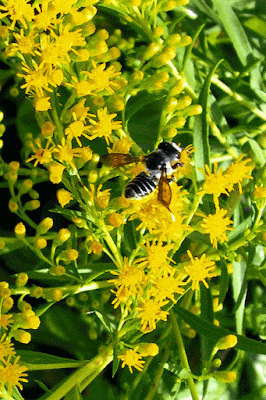 |
| A Leaf Cutter Bee Was Here! |
The species I see could well be native to Florida. It also could be Megachile rotunda, the "alfalfa bee," imported into the U. S. after the 1930's to: you guessed it! pollinate alfalfa fields. Honeybees are not efficient pollinators of alfalfa. This useful little critter has spread since then to much of the U.S.
The family of leaf cutter bees, Megachilidae, contains at least 2,000 species, and occurs virtually worldwide. Around 63 -75 species can be found in Florida alone. Another common leaf cutter bee, the "mason bee," Osmia sp., constructs its egg chambers with leaves and mud. Osmia bees are produced commercially and can be ordered over the Internet.
The Megachile bee is about the size of a honeybee. It does not sting unless provoked, and the sting is said to be less painful than that of a honeybee. It is somewhat chunky, with black and white bands on the abdomen and black on the upper thorax. Both sexes are generalist pollinators - they like just about everything. Only the female nests. Instead of packing pollen into leg pouches like honeybees, she carries it on the underside of her abdomen.
 |
Megachile on Heliotropium polyphyllum |
She will nest in just about anything the right size and shape - oarlocks, unused hoses, rotten wood, hollow twigs, burrows, or manmade nesting boxes. In Florida the bees also like holes drilled in stucco for fastening hurricane shutters! Nests in underground burrows don't seem to be affected by short-term inundation, or by getting gradually filled in.
Once she has found a suitable nesting place, the female cuts a round bottom plug, and then builds up the chamber with overlapping oval pieces of leaf. She cuts these sections out of leaf margins one at the time. She works smoothly and precisely, taking only a few seconds. She's so fast that you're lucky to catch her in action. She carries the leaf section slightly curved, under her abdomen, to her nest. I've timed a bee in action, from entrance to exit from burrow. She takes 60 to 90 seconds to get the new leaf section in place.
 |
| Megachile Carrying Oval Leaf Section |
When the chamber is complete she packs it with a mixture of nectar and chewed pollen, lays a single egg, and departs to cut the circular seal, or plug. This is when the closely related cuckoo bee. Coelioxys sp., may make her move. She crawls into the nest, and lays her egg, which will hatch and eat both pollen and competing larva.
The Megachile bee makes a series of chambers, one atop the other. The resulting cylinder is said to resemble a cigar somewhat. It would have to be a cigar no bigger in diameter than a straw. I extracted one from an oarlock one year and kept it in a dish. After a month or so, a faint, persistent buzzing told me that something was happening, and sure enough, one bee, followed quickly by another, emerged. At this point I took the bees and the rest of the cylinder outside where they belonged.
Leaf cutter bees live only a few months. The female dies after she completes her egg-laying. The larva pupates and overwinters in the nest as an adult until it emerges in the spring.
 |
| Megachile on Goldenrod |
If you're trying to grow a prize rose or dahlia for exhibition, the leaf cutter bee could be a nuisance. Otherwise, since they are solitary, not part of a colony, the damage they do is minimal, and I think just adds interest.
 |
| Megachile Work on Gopher Apple, Licania michauxii |
Honeybees have the reputation of being the best crop pollinators, but that is not necessarily the case. Our native bees are vital in the pollination of crops, ornamentals and our native flora. I don't know whether the one in my yard is a native or the imported alfalfa bee, but either way it is more than welcome.





